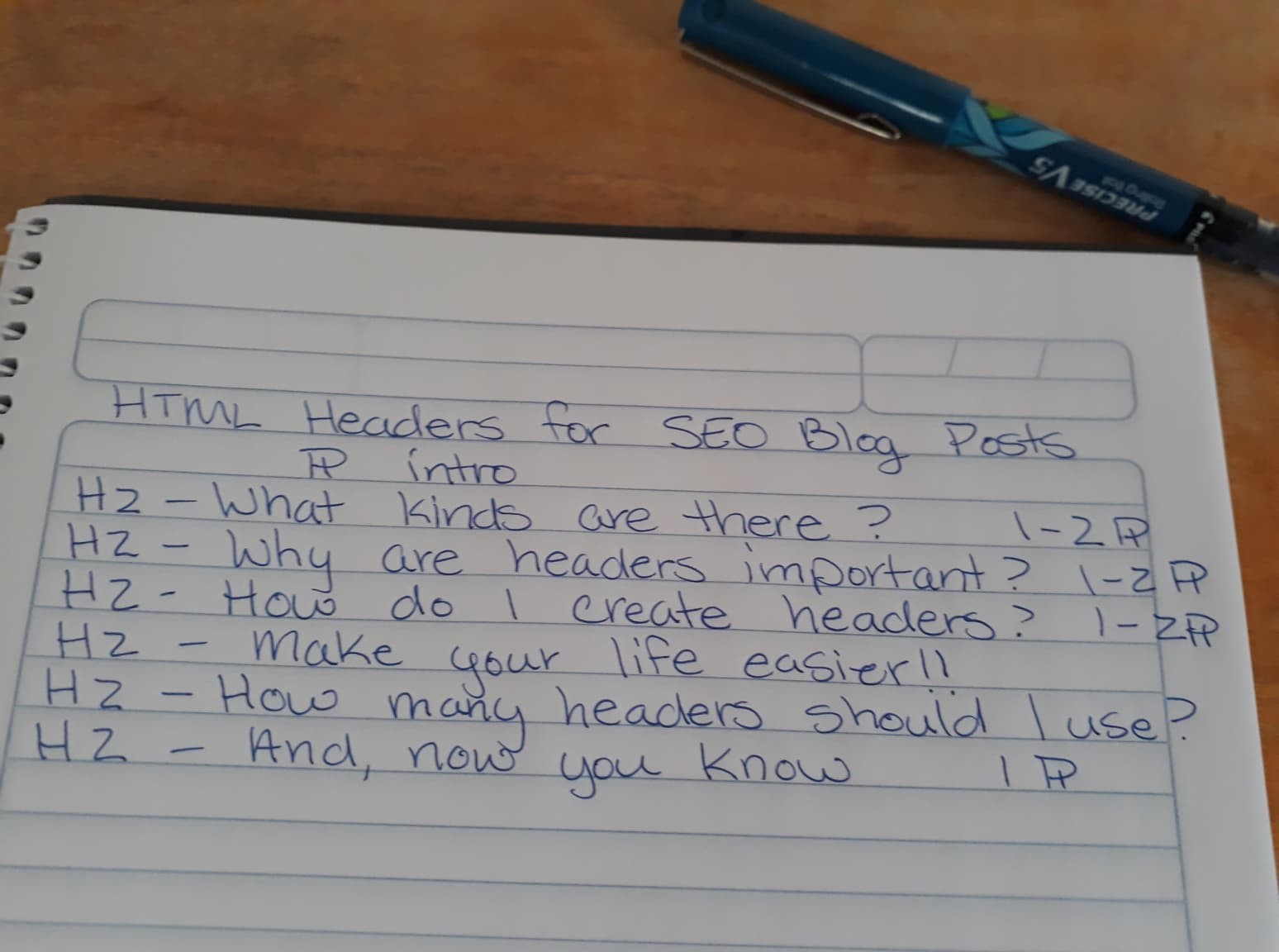HTML headers and subheaders are the introductory pieces of text that break up long blog posts into smaller, easier to read, blocks of text. For all intents and purposes, the following words and phrases related to HTML headers & subheaders are synonymous:
- H1 is synonymous with – HTML header, H1 header, Heading H1, Title
- H2 is synonymous with – HTML subheader, H2 (sub)header, Heading H2
- H3-6 are synonymous with – HTML subheaders, H3-6 (sub)headers, Heading 3-6
The title of this blog post is an example of an HTML H1 header. The question directly below is an HTML H2 subheader.
Table of Contents
What Kinds of HTML Headers & Subheaders are There?
There are H1-H6 headers. H1 headers are always, and only, used for the title of the blog post (see title above).
H2 subheaders are used to break up the text and set the reader up for the information in the paragraph(s) below it.
H3 subheaders can be used to break up the paragraph(s) under an H2 subheader if they get too long. For example, if you have a blog post about the costs involved in getting Botox treatments, your HTML headers & subheaders may be laid out like this:
- H1 – How Much Do Botox Treatments Cost?
- H2 – What Affects the Cost of Botox Treatments?
- H3 – Where you Live can Affect Treatment Prices.
- H3 – Botox Prices are Dependant on Your Gender.
- H3 – How Severe are Your Symptoms?
- H2 – What Affects the Cost of Botox Treatments?
Using H3 subheaders is a great way to break large amounts of text, making it easier for the readers to find the information they need.
HTML subheaders H4-6 will probably not be needed in SEO blog posts of less than 1500 words. If you do think you need to use them, just do so in descending order; H2, then H3, then, H4, etc.
Why are HTML Headers & Subheaders Important?
HTML headers & subheaders are important for three reasons:
- For the Reader – HTML subheaders break up large blocks of text, so it’s easier to read.
- For the Writer – HTML subheaders actually make blog posts faster and easier to write (see below).
- For Search Engines – Properly formatted HTML headers & subheaders tell search engines what your blog post is about so it can be shown in relevant search results.
So, as you can see, HTML headers & subheaders are a pretty important part of any SEO blog post.

Aren’t HTML Headers & Subheaders just Normal Text that is Bigger and Bolded?
In a word, no. You can take “normal text” and make it bigger and bold it, and it will look like an H2 header as far as the reader is concerned. Not as far as Google is concerned though.
Real HTML (sub)headers are formatted differently than “normal text”. Google searches for this formatting to determine if the content is relatable enough to return in search results.

How do I Create HTML Headers & Subheaders?
HTML Headers & subheaders are really easy to create. Just type your (sub)header in “normal text”. Then highlight that text and change it from “normal text” to “Heading 1” for the title, or “Heading 2” for the subtitles.
You can also create HTML (sub)headers using HTML coding. For the sake of this article though, we’re not going to get into that.

Also, when creating HTML (sub)headers, all of the text in the (sub)header is “Title Case”. What this means is that all of the longer words are capitalized (see the (sub)headers on this page).
Make Sure the Subheaders you Create are Relatable to the Title
Do not confuse your readers, or worse yet Google, with subheaders that are not relatable to your title. If your H1 title is “What Goes into the Costs of Botox Treatments?”, all of the subheaders should have something to do with Botox treatments.
These headers can be in the form of a question or a statement; “How does Gender Affect Botox Pricing?”, “How Often Will I Need Botox Treatments?”, “Your Geographic Location may Play a Role in the Price of Treatments”, etc.
Using Subheaders to Outline a Blog Makes Your Life Easier.
Using subheaders makes writing SEO blog posts so much faster and easier. When laying out a blog post it’s much easier to write the subheaders first and then go from there. This way, instead of looking at a blank page you need to fill with 1000 words, you now have 4-6 subheaders already written that you can treat as “mini-blogs” of 100-200 words each.

How many Subheaders Should I use in an SEO Blog Post?
As a general rule of thumb, you never want more than 300 words below an HTML header or subheader. Once you start to get huge blocks of text like that, readers start to tune out and stop reading. For our writing, I always try for between 50-200 words under each HTML header & subheader. If it goes longer I use an H3 subheader to break it up.
For blog posts of 500 words, you’re probably going to want between 3-5 subheaders, laid out like this:
- H1 – How Much Do Botox Treatments Cost?
- 50-word intro on Botox Treatments.
- H2 – What Affects the Cost of Botox Treatments?
- 50-100 words stating not all treatment costs are the same.
- H3 – Where you Live can Affect Treatment Prices.
- 50-100 words on why location could affect pricing
- H3 – Botox Prices are Dependant on Your Gender.
- 50-100 words on why Botox costs more for men than women.
- H3 – How Severe are Your Symptoms?
- 50-100 words on why lighter symptoms will cost less.
- H2 – Now That you Know the Costs of Botox, What are You Waiting For?
- 50-100 word closing with a CTA (call to action).
As I mentioned above, laying out your subheaders first makes writing the entire blog so much faster and easier.
And Now You Know About HTML Headers & Subheaders
Hopefully, this helped you with any questions you may have had with regards to HTML headers & subheaders. If you have any other questions about SEO blog writing or are looking for someone to help you with your SEO or blog writing, please don’t hesitate to comment below or contact us for more information.


One thought on “HTML Headers & Subheaders for SEO Blog Posts; H1, H2, H3”